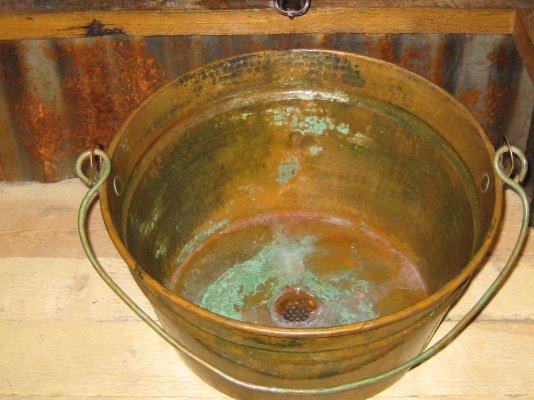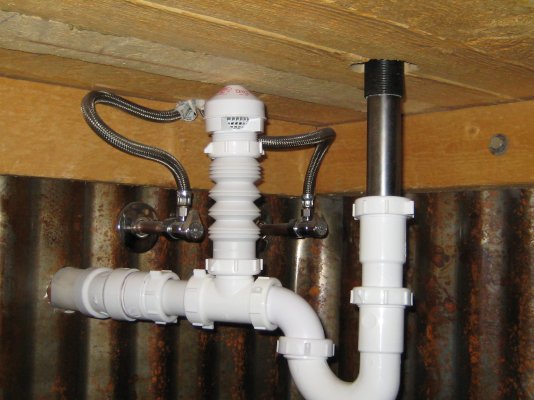Mark1
Full time employment: Posting here.
I'm getting ready to perform a remodel of a counter top in a ½ bathroom, but before I do any work I would like to understand the science and solve a slow draining sink issue in this bathroom. I was hoping someone on the forum would have an idea of what is occurring with my sink. Any suggestions (or experiments to conduct) would be greatly appreciated.
The issue doesn't seem to be related to restricted piping, but instead seems to be related to some type of pressure restriction. For example, if the sink basis contains only a small amount of water (say <1”) then it usually takes an extended period of time to drain (i.e. minutes), However, if the basis is allowed to reach a higher level (say 3 inches) then the basin seems to overcome some pressure restriction and always drained very quickly (few seconds). The bathroom designed is a rustic outhouse, so the sink basin is essentially a galvanized bucket as shown in the attached picture. I'm willing to wreck out the wall to get at the plumbing to solve this problem, but I would like to first understand what needs fixing.
I have talked to my normal plumber concerning this issue during a visit to solve a different issue and his response was that “the sink doesn't have a overflow hole so there is no where for the air to exist such that the water can drain”. This answer was less than satisfying, since my master bathroom sinks don't have overflow drain holes and they drain just fine.
I tried installing an aerator under the sink and even added a flexible piping segment such that I could vary the height (see photo). It may have helped the drainage slightly, but the difference was negligible.
I also tried installing a bundle of stainless steel straws of varying lengths within the drain tailpiece piping hoping it would allow an exist for the air if that was indeed the problem. This too was unsuccessful in addressing the issue.
The house is only 7 years old in an area with lots of county building inspector involvement, so I would like to think the house was built right (i.e. to code), but who knows . I bought the house when it was ~ 2 years old so I don't have any personal construction history.
. I bought the house when it was ~ 2 years old so I don't have any personal construction history.
I guess I can start to bring out different plumber to look at the sink, but I really would like to understand the science involved before I start wrecking out walls, etc. Thanks for any thoughts you might have
The issue doesn't seem to be related to restricted piping, but instead seems to be related to some type of pressure restriction. For example, if the sink basis contains only a small amount of water (say <1”) then it usually takes an extended period of time to drain (i.e. minutes), However, if the basis is allowed to reach a higher level (say 3 inches) then the basin seems to overcome some pressure restriction and always drained very quickly (few seconds). The bathroom designed is a rustic outhouse, so the sink basin is essentially a galvanized bucket as shown in the attached picture. I'm willing to wreck out the wall to get at the plumbing to solve this problem, but I would like to first understand what needs fixing.
I have talked to my normal plumber concerning this issue during a visit to solve a different issue and his response was that “the sink doesn't have a overflow hole so there is no where for the air to exist such that the water can drain”. This answer was less than satisfying, since my master bathroom sinks don't have overflow drain holes and they drain just fine.
I tried installing an aerator under the sink and even added a flexible piping segment such that I could vary the height (see photo). It may have helped the drainage slightly, but the difference was negligible.
I also tried installing a bundle of stainless steel straws of varying lengths within the drain tailpiece piping hoping it would allow an exist for the air if that was indeed the problem. This too was unsuccessful in addressing the issue.
The house is only 7 years old in an area with lots of county building inspector involvement, so I would like to think the house was built right (i.e. to code), but who knows
I guess I can start to bring out different plumber to look at the sink, but I really would like to understand the science involved before I start wrecking out walls, etc. Thanks for any thoughts you might have



